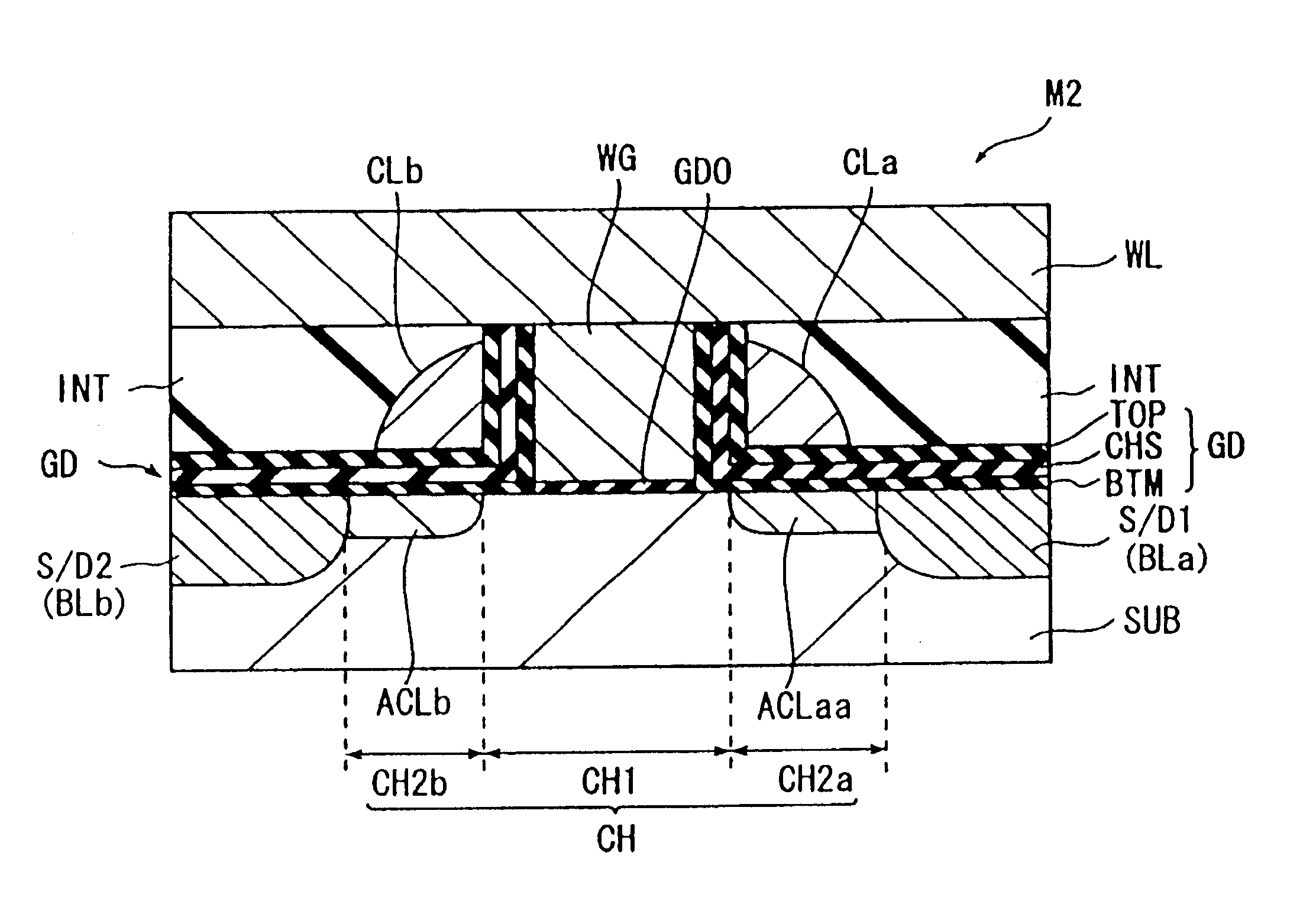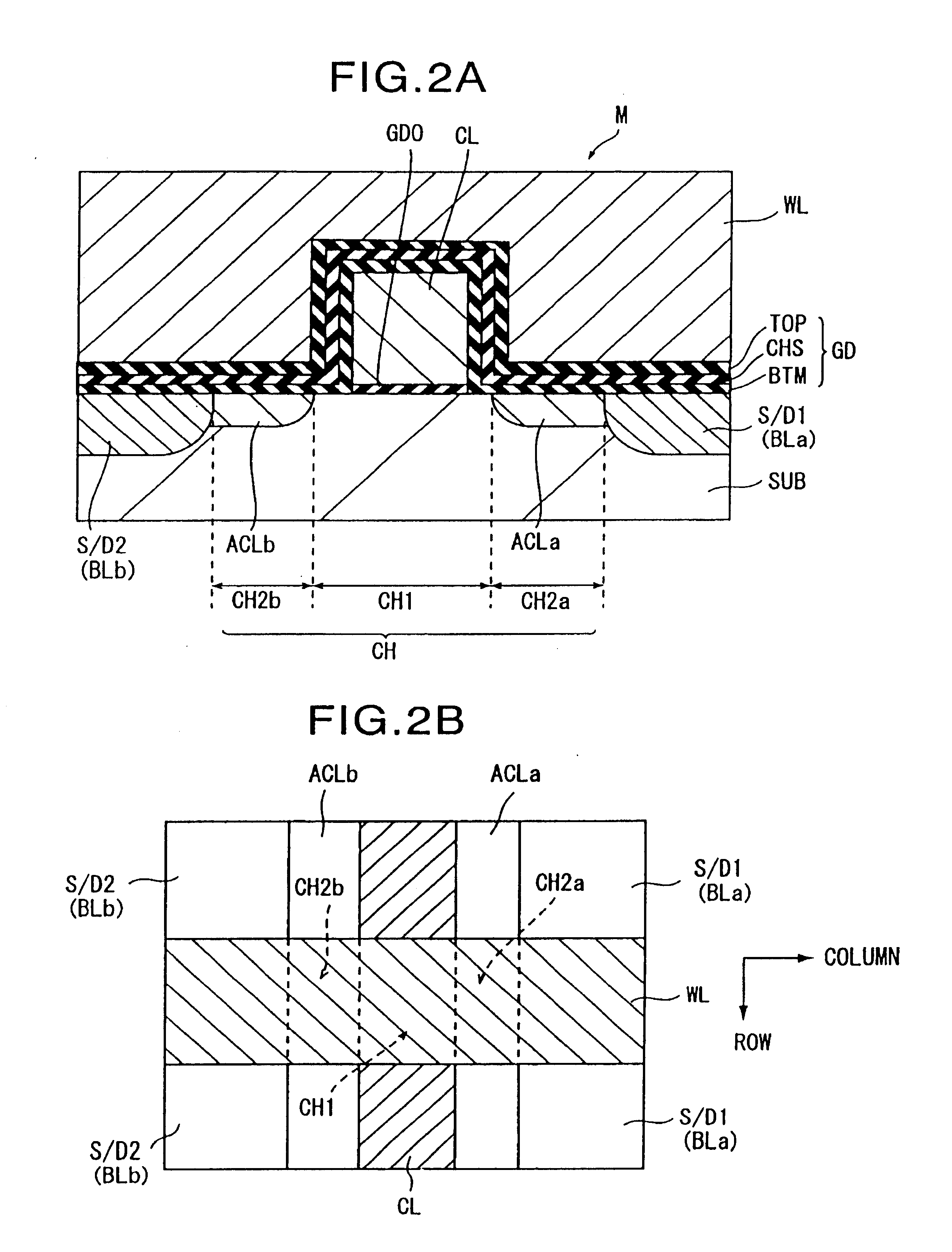Nonvolatile semiconductor memory device
a semiconductor and memory device technology, applied in semiconductor devices, transistors, instruments, etc., can solve the problems of insufficient efficiency and limit the improvement of the charge injection efficiency of the current source side injection method, and achieve the effect of high efficiency
- Summary
- Abstract
- Description
- Claims
- Application Information
AI Technical Summary
Benefits of technology
Problems solved by technology
Method used
Image
Examples
first embodiment
[0035
[0036]FIG. 1 is a view of an equivalent circuit of a non-volatile memory cell as a first embodiment of a non-volatile semiconductor memory device of the present invention.
[0037]A memory cell M has a three-transistor configuration comprised of a first memory transistor MT1, a control transistor CT, and a second memory transistor MT2, connected in series between 2 lines of bit lines Bla, BLb.
[0038]In the memory cell M shown in FIG. 1, gates of the two memory transistors MT1, MT2 are controlled by a word line WL, while a gate of the control transistor CT is controlled by a control line CL.
[0039]An operation voltage is controlled at the time of writing, erasing and reading data, and a column operation controlling means 1 for controlling the bit lines BLa, BLb and the control line CL, a row operation controlling means 2 for controlling the word line WL, and a substrate voltage controlling means 3 for controlling a voltage applied to the substrate are provided as operation controllin...
second embodiment
[0096
[0097]FIG. 12 is a view of an equivalent circuit of a non-volatile memory cell as a second embodiment of the non-volatile semiconductor memory device of the present invention.
[0098]In a memory cell 2 shown in FIG. 12, a gate of a control transistor CT is controlled by a word line WL, a gate of the memory transistor MT1 is controlled by a first control line CLa, and a gate of a memory transistor MT2 is controlled by a second control line CLb.
[0099]An operation voltage is controlled at the time of writing, erasing and reading data, and a column operation controlling means 1 for controlling the bit lines BLa, BLb and control lines CLa, CLb, a row operation controlling means 2 for controlling the word line WL, and a substrate voltage controlling means 3 for controlling the application of a voltage to the substrate are provided as operation controlling means supplied to the memory cell 2.
[0100]FIG. 13A is a schematic sectional view in a direction along a word line of the memory cell...
third embodiment
[0110
[0111]A third embodiment relates to a charge injection method for efficiently injecting holes at the time of erasing without using a negative voltage.
[0112]FIG. 15 is a view showing an erasure operation. A structure similar to the structure illustrated in FIG. 3A is shown. FIG. 16 is a chart showing erasure bias conditions. As an erasure operation, two modes (mode 1-1, mode 1-2) utilizing ionization colliding and a mode 2 utilizing inter-band tunneling are shown.
[0113]First, the mode 1-1 will be explained.
[0114]In the erasure of the mode 1-1, the operation voltage controlling means 1, 2, and 3 renders a source voltage Vs to be applied to the source / drain region S / D2 serving as a source, a substrate voltage Vsub to be applied to the substrate (first conductivity type semiconductor) SUB, and an erasure gate voltage Vmg to be applied to the word line WL all into a reference potential Vss (for example, 0 V). Under this state, the column operation controlling means 1 applies a prede...
PUM
 Login to View More
Login to View More Abstract
Description
Claims
Application Information
 Login to View More
Login to View More - R&D
- Intellectual Property
- Life Sciences
- Materials
- Tech Scout
- Unparalleled Data Quality
- Higher Quality Content
- 60% Fewer Hallucinations
Browse by: Latest US Patents, China's latest patents, Technical Efficacy Thesaurus, Application Domain, Technology Topic, Popular Technical Reports.
© 2025 PatSnap. All rights reserved.Legal|Privacy policy|Modern Slavery Act Transparency Statement|Sitemap|About US| Contact US: help@patsnap.com



